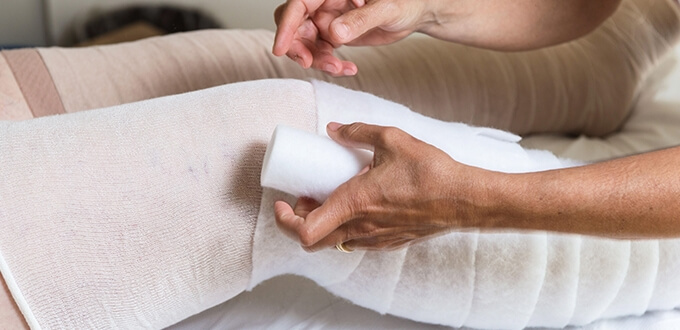Article written by: CRISTINA CONDURACHE, Kinetoterapeut
Actualizat: 15-06-2022 / Publicat: 24-08-2020

A key element of lymphedema treatment is compression therapy, which is done through bandages, clothing, or dedicated devices. This amplifies and maintains the decongestion effect of lymphedema obtained by manual lymphatic drainage.
Compressive bandaging is one of the methods used by Centrokinetic as part of the complex decongestant treatment (TDC), intended for patients with primary and/or secondary lymphedema, to promote lymphatic drainage, reduce edema volume, improve limb function and elasticity and limit complications.
To understand the role of compressive bandages, it is important to know how the lymphatic system works. Its role is to ensure the pressure balance between the various fluids present in the tissues, through the reabsorption in the interstitial space of fluids and catabolism products rich in proteins that come from the blood circulation. In the tissues affected by lymphedema, the elastic fibers are damaged. Especially in untreated lymphedema, which has reached an advanced stage, they lose their elasticity and tend to strengthen. Without proper treatment, lymphedema does not go away on its own but continues to progress. Edema can be reduced during treatment, but the damage to the lymphatic system is permanent, and the elasticity of the skin in the affected areas can never be restored to the previous level. The purpose of lymphedema management is to reduce lymphatic edema, with the help of intact lymphatic vessels, and to promote the creation of collaterals. Once the lymphedema is decongested, the secondary goal is to maintain edema reduction and prevent lymph fluid from accumulating again.
Compressive treatment is a key element in the treatment of lymphedema. Depending on the stage of treatment, compression therapy in lymphedema management is offered either by bandages, compression clothing, or compression devices. Used as a method of treatment on their own, they cannot reduce existing edema and therefore should not be worn on an area with uncongested lymphedema (by manual lymphatic drainage). However, without the benefits of external compression, successful management of long-term lymphedema would be very difficult and, in most cases, impossible.
We can explain how compressive therapy works on lymphatic drainage based on Pascal's law. This provides that the pressure variation produced at a point of an incompressible liquid (whose volume cannot be reduced) is transmitted entirely throughout the mass of the liquid. In other words, when a pressure exerted by a muscle contraction is applied on a fluid (lymphatic fluid) in a closed container (the compressive bandage that provides a counter-resistance to the skeletal muscles), this pressure is transmitted uniformly at all points of the bandage. It should be mentioned that the lymphatic system is unidirectional, and the pressure exerted by the bandage on the affected area decreases progressively from distal to proximal.
In short, the mechanisms that explain the effectiveness of compression therapy are:
- reduction of capillary filtration;
- diversion of fluids to parts of the body that are not subject to compression;
- increasing the speed of reabsorption of the lymphatic system and stimulating lymphatic circulation;
- improvement of the venous pump in patients with veno-lymphatic insufficiency and damage to the fibrosclerotic tissues.
In the intensive phase, it is recommended that the bandage be done daily, for 1-6 weeks, and that, in the maintenance phase, the bandages be replaced with compressed, individualized clothes. The pressure on the tissues must be uniform and firm.
Compression is more efficient when using inelastic materials (<10% elongation) or with short elasticity (10-100%). They produce high pressures during exertion and low pressures during rest, stimulating lymphatic circulation. Compressive bandages provide a resistance that allows the support and distribution of pressures created by muscle activity, necessary for the movement of interstitial fluids, to soften fibrotic tissue and stimulate lymphatic contractility.
Fasteners and/or fillers (foam, cotton wool) can also be used to protect the skin and to even out the pressure.
Compression clothing is very well suited for long-term use in the maintenance phase of lymphedema when the affected extremity is decongested. It is important to remember that any compressive clothing must be individualized, and its type and degree of compression are established by a lymphedema therapist or by a specialist.
Applying external compression provides the necessary support for issues that have lost elasticity and compensates for elastic insufficiency by increasing tissue pressure. Tissue pressure plays an essential role in the exchange of fluids between blood capillaries and tissues. The increased pressure on the tissues, provided by external compression, reduces the amount of fluid that leaves the blood capillaries in the tissues and increases the return of fluid from the tissue back to the blood and lymph capillaries, thus reducing the amount of fluid in the tissues. Also, external compression promotes venous and lymphatic return by improving the function of the valves of these vessels. It also helps to "soften" connective tissue, which is often fibrous in lymphedema.
All these effects help to prevent the re-accumulation of lymphatic fluid that was drained during complex decongestant treatment (TDC) and to preserve the results obtained by manual lymphatic drainage.
For information personalized to your case, make an appointment for a consultation at the Centrokinetic clinic. We are one of the few clinics in Romania that operate based on predefined medical protocols, developed following internationally established practices. Especially for patients with such conditions, we have developed a complex program, based on international guidelines and protocols used in the US since 2017.
Prices
You can find here a detailed list of the prices of individual services. But any correct recovery process is based on a mixed plan of therapies and procedures, customized according to the condition, stage of the condition, patient profile, and other objective medical factors. As a result, in order to configure a treatment plan, with the therapies involved and the prices related to the plan, please make an appointment here for an initial consultation.


































































































































